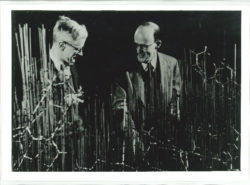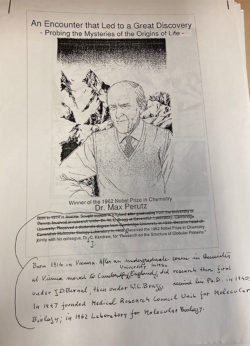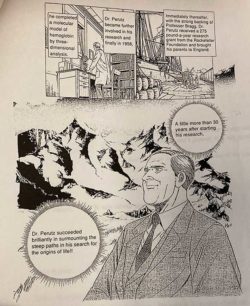
Max Perutz. Source: Churchill Archives Centre, PRTZ 6/2/8b.
Max Ferdinand Perutz (1914-2002) was a molecular biologist. Alongside John Kendrew, Max won the Nobel Prize for Chemistry in 1962 for co-discovering the structure of haemoglobin which transports oxygen around the blood. Amongst his papers is a comic strip of his life which survives alongside other biographical material.
Though we know little about who commissioned this comic, it nonetheless offers an insight into how the lives of prominent individuals are represented in cartoon form. The front of the comic carries a line drawing of Perutz in front of some mountains, signalling his love for mountaineering which had stayed with him since childhood.
The comic drawing captures Max’s frustrations at not meeting his father’s expectations on his career, his joy when his chemistry teacher told his students to abandon their textbooks, and the spark ignited in him from a simple class experiment.
In pictorially representing Perutz’s life, what moments are highlighted and concealed? What do specific textual and visual choices still tell us about the messages that the comic creator wanted readers to take away from Perutz’s life?
This comic strip survives with a wealth of other autobiographical material, as well as obituaries clipped from newspapers printed in the days after his death. Taken together, these documents not only tell us a great deal about Perutz’s life, but also invite researchers to think more broadly about the changing ways in which society commemorates the lives of scientists.


Source: Perutz Papers, PRTZ 7/1/6, Churchill Archives Centre.
Find out more about:
- The Perutz comic strip at Churchill Archives Centre.
- Max’s life using this timeline.
- Max in the biography Max Perutz and The Secret of Life (2014) or by listening to his oral history interviews deposited in the British Library’s National Life Stories Collection.
- How Max’s life was represented in cartoon form in Heroes of Health (2018), a book created by MRC London Institute of Medical Sciences to mark the 105th Anniversary of the Medical Research Council. Max’s comic begins on page 59.
Explore other comics, cartoons, and doodles in our collection:
- Doodles by Clement Attlee, 1940, FLUD 1/5.
- Lord Duncan-Sandys’s various doodles done during Cabinet meetings, 1951-1964, DSND 19/26/19.
- Research into children’s reading of comics and juvenile magazines, 1954, ABMS 3/50.
- 3 Japanese comic books in the collection of Sir Aaron Klug, 1992-1993, KLUG 6/2/8.
- Poster of cartoon figures of Danish kings in our Chartwell Manuscripts collection, CHWL/D 166.
- Sir Andrew Graham Gilchrist’s doodles, undated, GILC 30.
If we’ve whetted your appetite, then do get in touch to explore our collections.
Want to catch up with earlier posts in our series? Check out our blogs on autobiographies and biographies, letters, diaries and scrapbooks.
Looking for useful introductions for working with life writing? Here’s some of our favourites:
- Dobson, Miriam, and Benjamin Ziemann, eds. Reading primary sources: the interpretation of texts from nineteenth and twentieth century history. Routledge, 2020.
- Barber, Sarah, and Corinna Peniston-Bird, eds. History beyond the text: a student’s guide to approaching alternative sources. Routledge, 2013.
- Summerfield, Penny. Histories of the self: Personal narratives and historical practice. Routledge, 2018.
- Saunders, Valerie, “Life Writing”. In Victorian Literature, (accessed 4 Aug. 2021).
By Cherish Watton, Archives Assistant.
Subscribe to Churchill Archives Centre News
Enter your email address:
Subscribe to the Churchill Archives News RSS feed:
